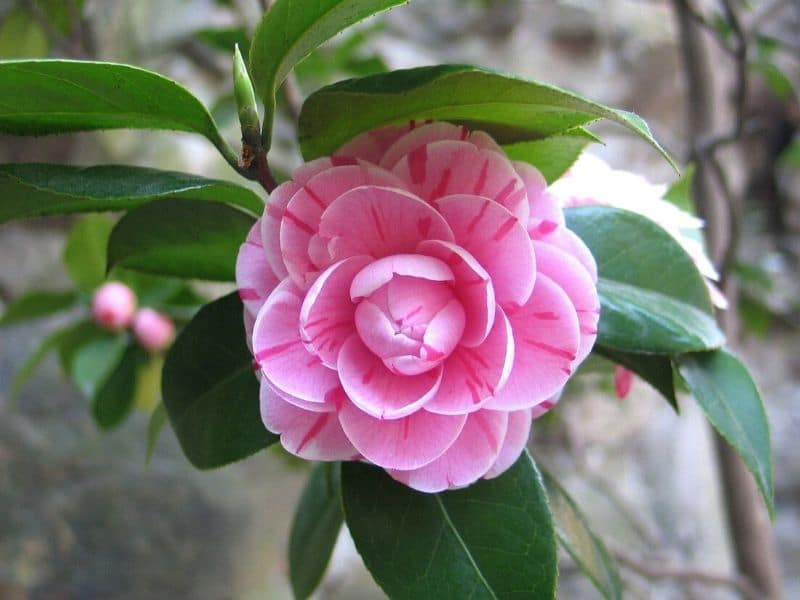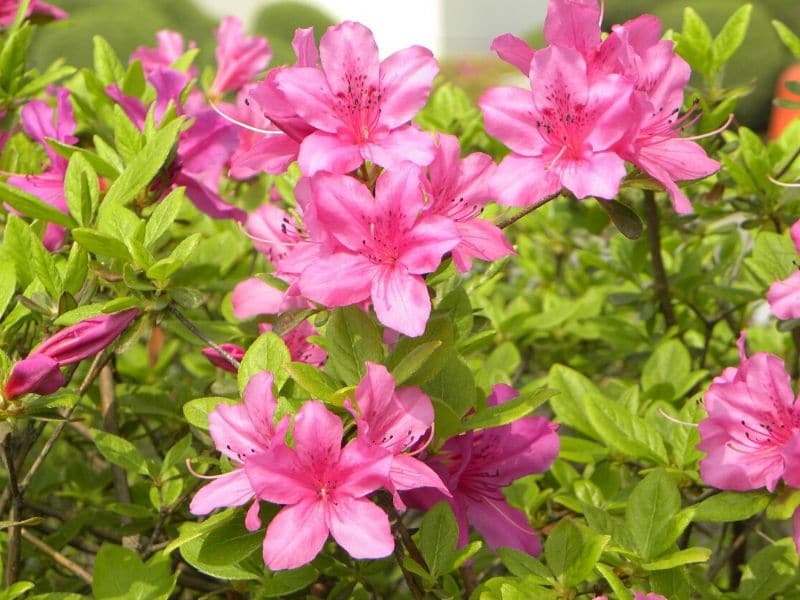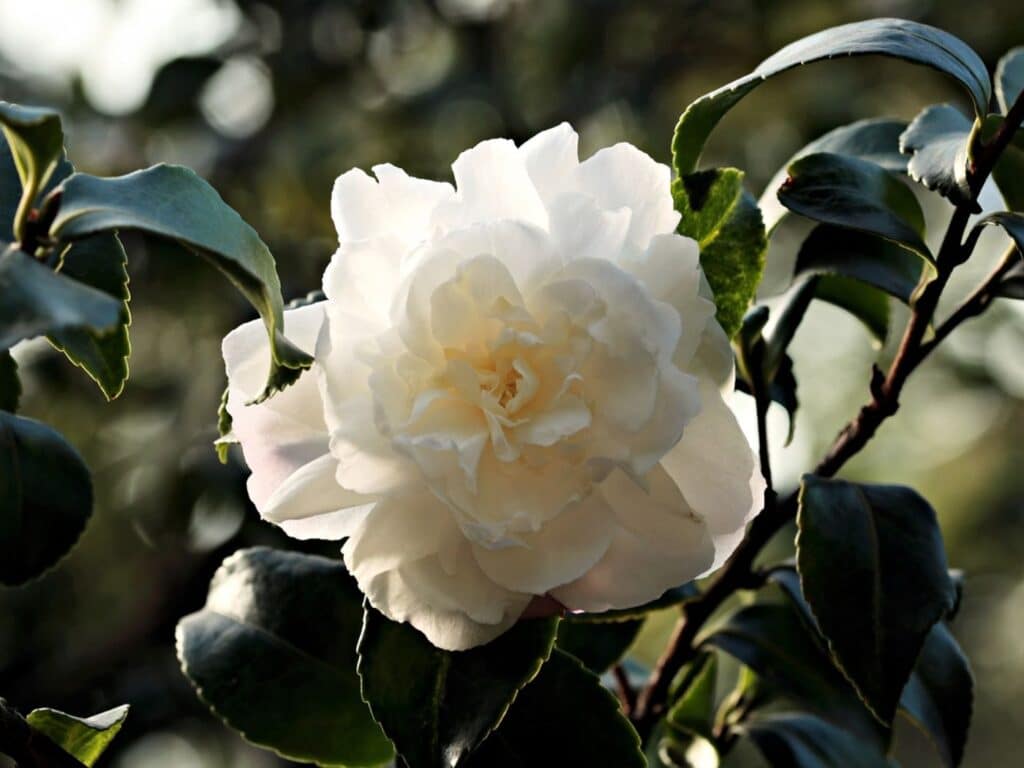Camellias (Camellia japonica) are often referred to as the queens of winter flowers. These shrubs or small trees are renowned for their exquisite blooms that look striking during fall and winters that tend to be dull.
It is the perfect plant to perk up your garden during winter time, and it will even look good during summer because it is an evergreen shrub.
If you are doing companion planting with camellias, it is best to focus on florals with a different bloom season to keep your garden brimming with bright flowers throughout the year. Some gardeners also pair camellias with bright foliage shrubs that can complement the vivid hues of camellias. You can also combine other winter-blooming plants in your garden to make your home stand out in winter.
Some of the best camellia companions include plants like azaleas, hydrangeas, bleeding hearts, coleus, and hellebores.
Let’s look at these beautiful plant species and discuss creative ways to use them in your garden.

What to Grow with Camellias
Camellias are sensitive plants that won’t grow well if they aren’t planted in a suitable environment. For successful companion planting, these flowering shrubs should be paired with plants that have similar growing needs.
Camellias grow well in dappled to full shade and prefer areas with lots of morning shade so the sun won’t dry out new developing flowers. They should also be shielded from winds.
These plants grow best in slightly acidic soil that drains well and should be kept moist. They greatly benefit from rich soil types with lots of organic matter.
Let’s look at some complementary plant species that grow well in moist and shaded positions.
Azaleas

Azaleas (Rhododendrons) are ideal camellia companions to grow a garden that offers year-round interest. While your camellias will bloom during the colder season, these flowering shrubs will keep your garden full of color and life from late spring to early summer.
Rhododendrons come in many colors, including orange, yellow, purple, red, pink, and white; the plants can vary in size. The plants can grow up to 20 feet tall, while camellias can reach up to 25 feet. These tall shrubs can be grown together to create striking hedges or privacy screens in your garden.
It is important to note that azaleas prefer sunny to light shade positions. Because they need more sunlight, it is usually best to grow them and camellias in the light shade areas of your garden.
Discover ideal companion plants to complement Azalea in your garden!
Hydrangeas

Hydrangeas (Hydrangea) are favorites in shaded gardens because they can brighten darker spaces with vivid green foliage and show-stopping flower clusters. These shrubs are great companion plants for camellias and can be used to create showy hedges or privacy screens in your garden.
Hydrangeas won’t flower at the same time as camellias, but they will add lush color to your garden from mid-spring to early fall. It is common for this perennial to shed its leaves during winter, but this is ideal since it will allow your camellias to stand out even more.
These vivid flowers will grow well in light sun to full shade positions and thrive in moist soil conditions.
It is best to grow these flowering shrubs before your camellia trees because they usually only grow 4 – 12 feet tall and can be good for concealing the base of your taller shrubs.
Bleeding Hearts

Bleeding hearts (Dicentra spectabilis) are good camellia companion plants because they thrive in part-shade positions with lots of moisture. These beautiful woodland shrubs produce bright pink flowers in late spring that can keep your garden vivid after the camellias shed their blooms.
The evergreen shrubs will also add much texture to your garden with their delicate foliage. It is best to position this perennial shrub towards the front of your garden because they are shorter, with a maximum height of 5 feet.
Coleus

Coleus plants (Coleus) are ideal companion plants to grow in your garden if you want to add year-round interest to your spaces. This foliage plant is prized for its interesting leaf colors. The leaves of this plant can range from purple, yellow, intense red, pink, or chartreuse to lime green, and the foliage can be spotted, splashed, or patterned.
Coleus plants grow well in partial shade and need moist but well-drained soil. They tend to be low-growing and should be positioned toward the front of your garden.
For a striking effect, you can combine camellias with complementary coleus varieties. Bright purple camellias should look striking behind a purple coleus variety, or pair it with a vivid green variety to contrast your garden.
It is important to note that coleus can act like an annual in colder regions because they are not too cold tolerant.
Hellebores

If you are looking for another winter-blooming perennial to pair with camellias, you should consider hellebores (Helleborus). These fantastic flowers bloom from late fall to spring, and their flowers can be fascinating since they come in unusual hues with pastel tones or exciting patterns.
These woodland flowers grow well in partial shade and need well-drained, rich soil. They are easy to grow and don’t require too much maintenance and care.
You should mass plant hellebores in the garden bed around your beautiful camelia shrub for optimal results. The combination of bright and pastel tones will keep your garden cheerful during the cold and dull winter season.
What NOT to Grow with Camellias
Camellias will perish fast if they are too exposed to sunshine or do not receive adequate water. Their roots can also start to rot if they aren’t placed in free-draining soil.
These sensitive plants are poor companions for drought-tolerant and sun-loving plant species like sunflowers, Russian sage, coneflowers, geraniums, or catnip.
Landscaping Ideas for Camelias and Companions
Camellias can be paired with other plants to create showy spaces or exciting garden features. Here is a quick look at how this plant and its companions can perk up your garden.
Privacy Screens
You can use camellias and other evergreen shrubs like azaleas to create showy privacy screens in your garden. Both of these shrubs are rather tall and will look beautiful all year because camellias blossom during the colder months and azaleas offer a lot of color to your yard during the hot months.
Garden Centrepieces
Camellias are often used as a statement piece or accent plant in gardens because they tend to stand out during winter. You can place this plant in the center of a garden bed with lots of winter bloomers like hellebores mass planted all around it to create an eye-catching effect.
Borders
Camellias can be lined up to form a showy border in your garden. This border can be layered by pairing it with a shorter perennial like hydrangeas, coleus, or bleeding hearts to create a border or layer with lots of dimension. The dimensional border can look showy alongside a wall or driveway.
Final Thoughts
Camellias will add lots of color and cheer to your garden in winter. They can be paired with other winter-blooming plants like hellebores or colorful foliage plants like coleus to make your garden look more attractive during the colder months. This beautiful evergreen shrub can also be combined with other shrubs like azaleas, bleeding hearts, or hydrangeas if you want to add color to your garden during summer and spring.
We hope you enjoyed our companion planting guide and will have lots of fun combining these plant species in your garden.
Learn more about Camellia symbolism to see why people love this flower!







